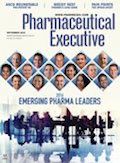Rise of the Vox Populi
Pharmaceutical Executive
Big pharma has become increasingly vulnerable to larger geopolitical and macroeconomic risks-a realization that has slowly creeped into their business planning.
As the world’s leading maker of medicines-an essential public good-you might think that big Pharma has a healthy sense of its own vulnerability to geopolitical risks. A closer look at the industry’s armamentarium to counter everything from macroeconomic headwinds to reputational hits from local politicians
William Looney

suggests otherwise.
Company investments in NGO advocacy and academic policy research are down. Trade association initiatives to build cross-industry consensus to shape the external environment have been sidelined by beggar-thy-neighbor competition for product access. Waves of M&A consolidation have eclipsed the painstaking task of stakeholder engagement, resulting in ever larger companies with the internal distractions-and inertia-of a mini nation state. Most important, the industry has lost the leveraging power that comes from speaking with a single voice. It signals a diminished capacity to influence a world where resolving problems depends on group affiliations.
Big Pharma may no longer be viewed as an authoritative player in global policy debates. In a July 29 online post in Nature Drug Discovery, former Goldman Sachs chief economist Jim O’Neill, chair of a UK government inquiry on antimicrobial drug resistance (ADR), referred to the biopharmaceutical industry using words like “unimaginative” and “narrow-minded,” noting sarcastically that the industry welcomed everything in his team’s report, “except for the section that said they’d have to spend more money.” O’Neill’s position in the top tier of finance hardly paints him as a bomb thrower, but still he offers faint praise for drugmaker’s political savvy, claiming that “the pharmaceutical world thinks our proposals (for a new ADR drug financing mechanism) just popped out of my team’s head.”
Underlying O’Neill’s critique is big Pharma’s habit of failing to look at the big picture. Attacks on its pricing and R&D model get the most attention in the C-suite, but there are two larger, transcendent forces that may add considerably to the industry’s exposure to risk.
First is the backlash against globalization, a way of organizing commerce and institutional relationships that, over the past half-century, has arguably benefited biopharma more than any other sector. Cost and quality efficiencies from a globally integrated supply chain is one example; so too is the progress made on convergence of national regulatory and surveillance standards as well as multilateral endorsement of a minimum benchmark for IP protection and enforcement, across borders. Second is declining economic growth and productivity, driven by a persistent lag in private investment. This is evidenced from both a sectoral and geographic perspective: the IT revolution has yielded up much of its connectivity gains, with Internet access stabilizing at roughly three billion users worldwide, while once-promising emerging country markets face higher debts and other structural challenges that have pushed GDP growth well below the double-digit rates of the past decade. In Europe and Japan, demand is flat and deflation has taken root.
The consequences for pharma of these two macro trends are damaging. Opposition to globalization has imperiled the Trans-Pacific Partnership treaty (TPP), a US-led effort to counter China’s mercantilist influence over Asia’s most promising future markets for healthcare, with a consistent standard for IP recognition of next-generation, US-grown biologics included as part of the core package. Likewise, in a deglobalizing world, there is little prospect for a globally aligned strategy on market access: limiting the bleed from compulsory licensing and reference-based pricing only to the poorest countries with a recognized emergency need.
Stagnant growth is even worse. A lot of the fiscal deficit friction targeting the drugs bill could be avoided if the US and Europe delivered a GDP growth rate at the historical post-war standard of 3% or more. There is no better “grand bargain” for health than that. And the best way to secure it, here in the US, is a comprehensive tax reform benchmarked to the competitive rates set by our key trading partners-the global approach. The last such reform took place back in 1986, when US drug industry revenues were $25 billion, less than 10% of the estimated $300 billion US-based drugmakers now have idling abroad, awaiting a change in the law.
The good news is big Pharma is beginning to incorporate awareness of this troubling macroeconomic landscape in their business planning. Proactive assessment of currency, economic and tax trends is now part of the CFO skill set, while the globalization backlash is now ingrained in contingency planning for foreign investments. Indeed, the politics behind the recent acquisition battle between Pfizer and AZ reveals that being stateless in a world of nation states is not an option. Adjacent sectors like banking are signaling the way. Citicorp has coined a new form of business risk in the years to come-Vox Populi risk-where the “will of the people” mutates to the unpredictable agida of the flash mob.
William Looney is Editor-in-Chief of Pharm Exec. He can be reached at william.looney@ubm.com. Follow Bill on Twitter: @BillPharmExec

Regeneron, Roche Launch Major US Expansion Plans to Meet Growing Demand for Biologics and Innovation
April 22nd 2025With combined investments exceeding $53 billion, both companies are deepening their US presence through expanded biologics production, gene therapy capabilities, and next generation R&D centers.
Cell and Gene Therapy Check-in 2024
January 18th 2024Fran Gregory, VP of Emerging Therapies, Cardinal Health discusses her career, how both CAR-T therapies and personalization have been gaining momentum and what kind of progress we expect to see from them, some of the biggest hurdles facing their section of the industry, the importance of patient advocacy and so much more.